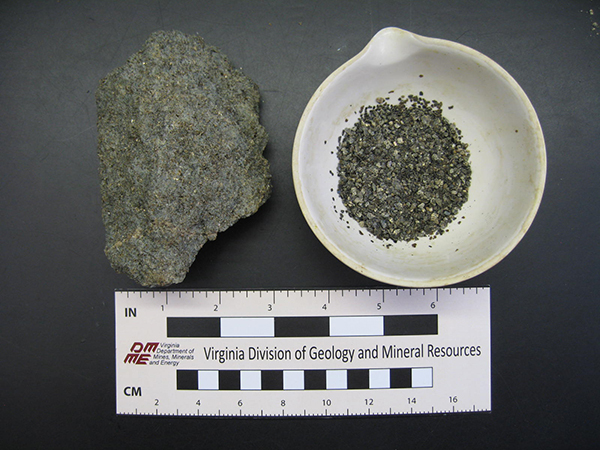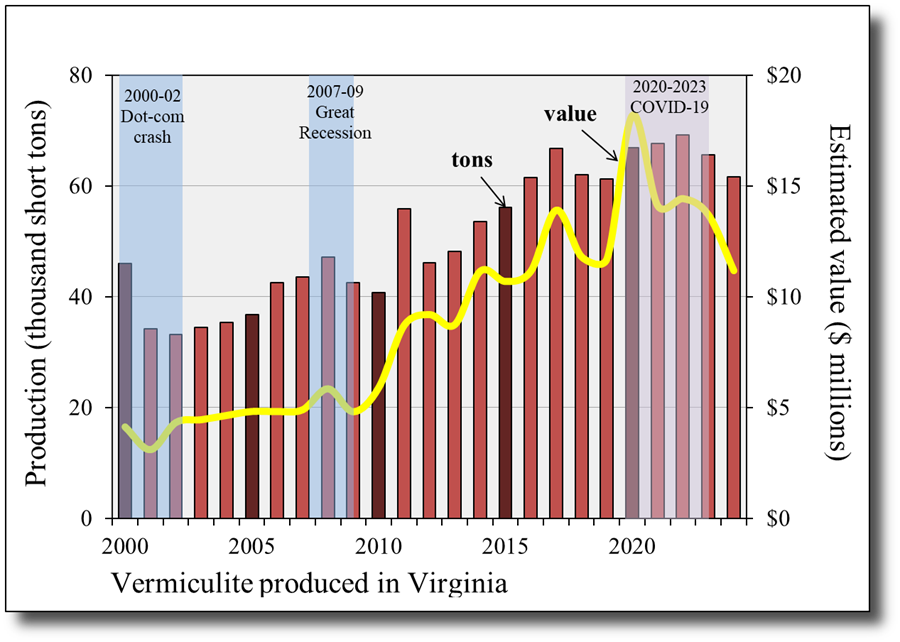
Vermiculite ore and #3 concentrate (1-2 millimeter size fraction)
Vermiculite is a clay mineral group with the general chemical composition (Mg,Fe,Al)3 (Al,Si)4O10) (OH)2•4(H2O). Often occurring as an alteration product of biotite mica or chlorite in the near-surface zone of weathering, vermiculite is typically found associated with ultramafic rock types such as peridotite and pyroxenite that have been previously altered by intrusions of granite, pegmatite, or alkalic rocks. Vermiculite occurrences have been documented in several areas in the Piedmont province of Virginia within Buckingham, Bedford, Charlotte, Franklin, Halifax, Henry, Louisa, and Pittsylvania Counties (Gooch, 1957). To date, only one of these occurrences, in Louisa County, has been developed as a commercial deposit.
As a hydrous mica-like mineral, vermiculite expands rapidly when heated to temperatures >900° C. The contained water converts to steam forcing individual mineral laminae apart, a process known as exfoliation. The expansion results in low-density mineral granules that can be 6-20 times the original volume. These granules are chemically inert, refractory, and highly-absorptive, making the material highly valued in construction applications such as plaster and cement premixes, lightweight concrete additives, as an industrial absorbent, and in fireproof and sound insulation. Depending on the specific chemical composition, vermiculite may also be characterized by high cation-exchange capacity making it valuable in agricultural and horticultural products.
Year of first production in Virginia: 1978
County locations with commercial mining (past and present): Louisa County
Quantity produced in 2024: 61.6 thousand tons
Estimated value1 of produced minerals in 2024: $11.2 million

Since 1978, Virginia Vermiculite LLC has been the sole commercial producer of vermiculite in Virginia, operating a surface mine just west of Trevilians, in Louisa County. This mine is one of two in the United States that mines and processes vermiculite concentrate, the other being located in South Carolina. The deposit occurs in an 80- to 100-foot thick weathered zone in mafic rocks of the Green Springs pluton. Vermiculite content in the ore varies from about 15 to 50 percent. After the soft ore is excavated and initially screened, the vermiculite particles are concentrated using wet-screening and flotation circuits. The concentrate is dried in a rotary dryer and screened to produce several final product sizes and blends. The concentrate can also be further processed into exfoliated and milled products for various applications. The products are shipped in bulk by truck, rail, and ocean freight vessels to domestic as well as international customers.

Annual production reported by mine operator1
1 Estimates of annual mineral value are calculated using tonnages reported to Virginia Energy and commodity sales prices reported in numerous published and unpublished sources. The prices may include national or global industry averages. The calculated annual values do not necessarily reflect the actual sales prices received by mine operators in Virginia.
Selected References:
Gilmer, A. K., Enomoto, C. B., Lovett, J. A., and Spears, D. B., 2005, Mineral and fossil fuel production in Virginia (1999-2003): Virginia Division of Mineral Resources Open-File Report 05-04, 77 p.
Gooch, E. O., 1957, Vermiculite: Virginia Division of Mineral Resources, Virginia Minerals, v. 3, n. 1, p. 1-6.
Tanner, A. O., 2017, Vermiculite: U.S. Geological Survey Mineral Commodity Summaries 2017, p. 184-185.
Virginia Division of Mineral Resources, 1993, Geologic Map of Virginia: Virginia Division of Mineral Resources, scale 1:500,000.
